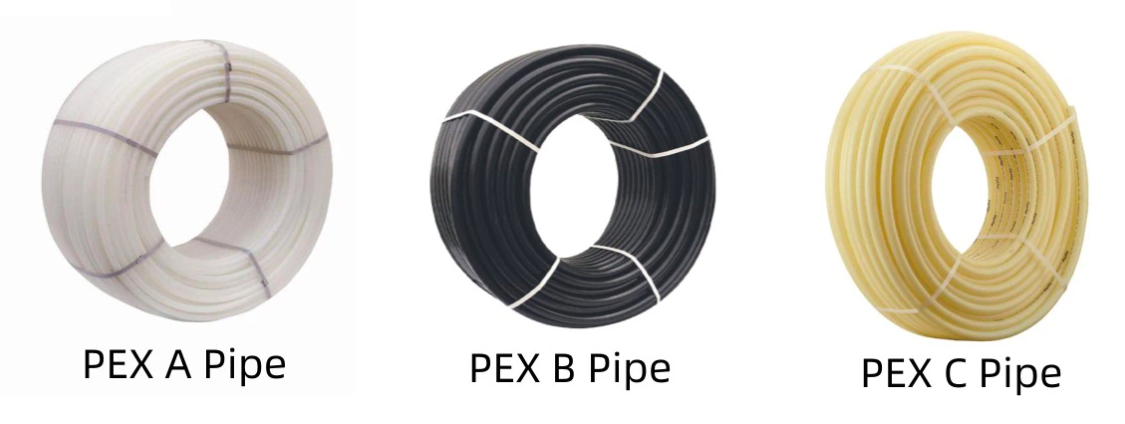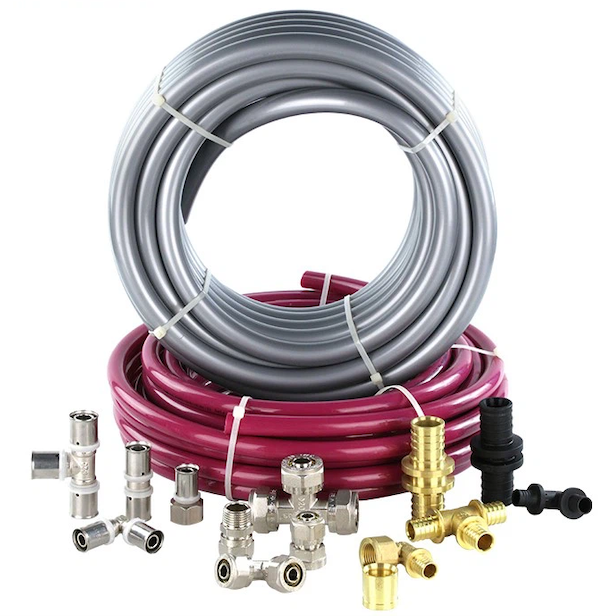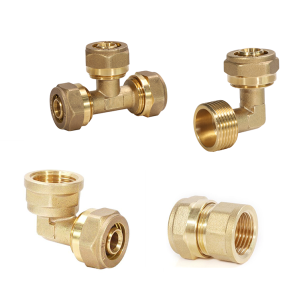Table of Contents
ToggleIntroduction
Brief overview of Polyethylene (PEX) pipes
Polyethylene (PEX) pipes are a form of plastic piping that have been used extensively in residential and commercial plumbing systems due to their flexibility, durability, and other notable advantages over traditional piping materials like copper pipe or PVC pipe.
The term "PEX" stands for cross-linked polyethylene. The "cross-linking" refers to the process where polyethylene polymer chains are chemically bonded together, improving their high temperature properties and chemical resistance.
There are three main types of PEX pipes - PEX-A, PEX-B, and PEX-C, each manufactured using a different method: the Engel method for PEX-A, the Silane method for PEX-B, and the Electron Beam method for PEX-C. These types vary in their flexibility, resistance to cracks or leaks, and their level of consistency across the width of the pipe.
PEX pipes have gained popularity due to their benefits such as easy installation, resistance to scale and chlorine build-up, low thermal conductivity, and high-temperature resistance. They are widely used in radiant floor heating, snow melting, plumbing, water service lines, and fire sprinkler systems.
Despite their advantages, PEX pipes are not suitable for outdoor use exposed to sunlight as UV radiation can damage the material. So need pex insulation pipe to protect. They also cannot be directly connected to a water heater but must use an appropriate connector to prevent damage from high temperatures. And their popular sizes are the same, like 1/2” pex, 3/4” pex, 1” pex to 2” pex pipe, with same pipe fittings, like pex compression fittings, pex press fittings, pex expansion fittings, pex crimp fittings, pex push in fittings, pex sliding fittings, etc.
Overall, PEX pipes represent a versatile, cost-effective alternative to traditional plumbing solutions, providing excellent performance and value for homes and businesses.
Understanding PEX-A Pipes
Description of PEX-A pipe structure and manufacture process
PEX-A or crosslinked polyethylene-A pipes are becoming a fixture in the plumbing industry, and for good reason. In order to appreciate the appeal of these pipes, let's delve into its distinctive structure, benefits, and where they are most commonly used.
A: Description of PEX-A Pipe Structure and Manufacture Process
The manufacture of PEX-A pipes involves a process called the Engel method, which enables a high degree of cross-linking. Cross-linking is the process where polymer chains are connected, forming a three-dimensional network of linked molecules. This complex structure is the backbone of PEX-A's standout features, contributing to its flexibility and durability.
B: Unique Features and Benefits of PEX-A Pipes
PEX-A pipes boast a myriad of unique features and benefits that set them apart from traditional piping options. They stand out for their superior flexibility, enabling them to be bent around tight corners without requiring additional fittings. This high degree of pliability simplifies the installation process significantly.
Furthermore, they exhibit a high resistance to stress, cracking, and extreme temperatures. Their thermal memory allows them to return to their original shape after being deformed, which enables an extremely effective seal with fittings. Their impressively robust nature translates to less maintenance and a longer lifespan.
C: Common Applications of PEX-A
PEX-A pipes are versatile and can be applied in various sectors. They are widely used in residential and commercial plumbing systems for their ease of installation, low cost, and reliability. They are also the ideal option for radiant floor heating and snow-melting applications thanks to their temperature resilience and thermal performance.
Moreover, with their corrosion resistance, they're also becoming a popular option in fire sprinkler systems, ensuring robust and effective water supply when it's needed most.
In conclusion, understanding PEX-A pipes, their structure, benefits, and applications, can aid homeowners, builders, and various other stakeholders in making informed decisions about their plumbing systems. Indeed, PEX-A pipes signify innovation, efficiency, and assurance, making them a popular choice in modern plumbing solutions.
Exploring PEX-B Pipes
PEX-B pipes are highly esteemed in various sectors and continue to gain favor in the evolving plumbing industry. Let's delve into the unique characteristics of PEX-B, starting with its structure, then expounding on its benefits, and finally, exploring its applications.
A: Description of PEX-B Pipe Structure and Manufacture Process
PEX-B pipes, also known as Crosslinked Polyethylene Type B, are produced using the Silane or moisture cure method of crosslinking. This process involves introducing silane compounds to the polyethylene, followed by exposure to heat or a catalyst that induces crosslinking, thereby forming a three-dimensional molecular network.
Compared to PEX-A, the crosslinking of PEX-B occurs after the pipe is extruded, providing a distinct structure that differentiates it from other PEX types.
B: Unique Features and Benefits of PEX-B Pipes
PEX-B pipes are characterized by their impressive durability and strength. They offer high resistance to stress, cracking, and chemical attack, making them particularly resilient to varied plumbing situations.
Aside from strength, these pipes stand out in terms of thermal conductivity, exhibiting a lower level compared to other PEX types. Furthermore, PEX-B pipes are also noted for their dimensional stability and ability to withstand high-pressure applications.
Although not as flexible as PEX-A, they maintain satisfactory pliability, making installation manageable and straightforward. With respect to cost, PEX-B offers a more economical option while maintaining excellent performance and longevity.
C: Typical Applications of PEX-B
PEX-B can be found in a wide array of applications, making it a versatile choice. Residential and commercial plumbing systems often opt for PEX-B for its durability and enhanced performance under high pressures.
These pipes are also an asset in radiant heating systems due to their effective thermal conductance. PEX-B is even found in complex network pipe systems, capable of withstanding substantial traffic and usage.
To conclude, diving into the world of PEX-B, from its unique structure to its outstanding benefits and vast applications, reinforces its place as a valuable player in the plumbing sphere. Its performance under varying conditions and cost efficiency make PEX-B an attractive choice for homeowners, builders, and commercial installers alike.
Getting to Know PEX-C Pipes
PEX-C pipes, though less known as compared to PEX-A and PEX-B, are an imperative part of the PEX family. Let's take a journey to understand the structure, advantages, and common uses of PEX-C pipes.
A: Description of PEX-C Pipe Structure and Manufacture Process
PEX-C, or Crosslinked Polyethylene Type C, is formed by the method known as electron beam processing. This technique involves bombarding polyethylene with high-energy electrons, causing the material's molecules to crosslink. The process typically occurs after the material is extruded into pipe form, giving PEX-C its distinctive structure.
B: PEX-C's Unique Features and Benefits
Despite being less flexible than its PEX counterparts, PEX-C is valued for its excellent strength and stability that contribute to its resistance to stress and cracking. The electron beam process used in its manufacture gives PEX-C a smoother, shinier exterior which some find more visually appealing.
The process also produces less chemical residue, making PEX-C a more environmentally friendly option. Moreover, PEX-C pipes are known for their dimensional consistency, ensuring a reliable performance in various conditions.
C: Understanding Typical Applications of PEX-C
PEX-C pipes have versatile applications due to their robust characteristics. They are commonly used in residential and commercial plumbing systems, providing reliable functionality due to their inherent resistance to the problems that often plaque metal pipes such as corrosion and scaling.
Also, PEX-C pipes' consistency lends them well to applications that require precise measurements, like underfloor heating systems. Their stability ensures they retain their shape, providing a dependably steady performance. Additionally, due to their clean manufacturing process, they are becoming increasingly popular in applications geared towards sustainability and environmental consciousness.
In conclusion, PEX-C pipes, with their unique manufacturing process, impressive features, and wide-ranging applications, hold their own as part of the PEX pipe family. Their strength, stability, and consistency make them a compelling choice whether in a family home's plumbing system or a large-scale commercial application.
Comparing PEX-A, PEX-B and PEX-C
Pex B vs Pex A vs Pex C
Property | Other PEX-A | PEX-B | Other PEX-C | |
Manufacture Method | Peroxid / Engel | Silane | Electron Beam | |
Cross-linking Degree | 85% | 65% | 75% | |
Flexibility | Better flexibility than PEX-B | Stiffer to work and bend | Varies by mfg. | |
Strength | Meets ASTM | Meets ASTM | Meets ASTM | |
Homogeneity | Not very good | Good | Good | |
Thermal Memory | Good | Decreases after heating to transparency | Decreases after heating to transparency | |
Kink Reparability | Excellent | Decreases after heating to transparency | Decreases after heating to transparency | |
Kinking resistance | Good | Fair | Fair | |
(More vulnerable to be Kinked) | (More vulnerable to be Kinked) | |||
Barrier property | Meets DIN 4726 | Meets DIN 4726 | Meets DIN 4726 | |
Thermostability | Better than ASTM requirements | Better than ASTM requirements | Better than ASTM requirements | |
Memory effect of being coiled | Fair - Better than PEX-B | Poor | Poor | |
Minimum bending radius | Good - Better than PEX-B | Poor - The worst of all PEX types | Varies by Mfg. | |
Kinking resistance | Good - Better than PEX-B | Poor | Varies by Mfg. | |
Density | 0.938 - higher | 0.941 - highest | 0.941 - highest | |
Cost | Expensive | Cheaper | Most Expensive |
A: Performance Comparison - Pressure Resistance, Temperature Variability, Durability
PEX A pipes are widely praised for their exceptional flexibility and durability. They offer high resistance to both pressure and temperature variations, and their excellent thermal memory restores the pipe to its original shape after deformation.
PEX B pipes, though not as flexible as PEX A, offer impressive strength and good resistance to pressure changes and cracking. They also have slightly lower thermal conductivity compared to the other two, which can be advantageous in certain applications.
PEX C pipes, manufactured through the electron beam process, offer a high level of strength and exhibit great dimensional stability. While slightly less flexible than its counterparts, it compensates with its resistance to stress and its smoother, shinier exterior.
B: Comparison of Installation Processes
All three types of PEX pipes provide an easier installation process compared to traditional metal pipes. However, PEX A stands out the most with its superior flexibility, requiring fewer fittings even for sharp turns. This simplifies and accelerates the installation process.
PEX B, although less flexible, is still easy to install but might require more fittings due to its stiffer nature. As for PEX C, it's a bit more rigid, but its dimensional stability makes it easy to work with in projects requiring precise measurements.
C: Cost-Effectiveness Comparison
In terms of costs, all three types of PEX pipes offer long-term economic benefits because of their durability and lower maintenance requirements. PEX B pipes are generally more cost-effective upfront due to the efficient manufacturing process.
PEX A pipes, while slightly more expensive initially, can minimize costs in the long run due to their excellent durability and reduced need for fittings. PEX C pipes, being more environmentally friendly due to minimal chemical residue during manufacturing, also offer potential savings from a sustainability perspective.
Conclusion
In conclusion, while PEX-A, PEX-B, and PEX-C all have impressive qualities that make them viable options for different applications, understanding their distinct features, installation requirements, and cost-effectiveness allows one to make a well-informed decision. Despite their differences, all three types underline the value of PEX pipes in providing effective and efficient plumbing solutions.

















Do all pex pipes have memory, meaning they do not require pex rings for installations?
Not all PEX pipes have “memory” that negates the need for PEX rings (also known as PEX crimps or PEX clamps) in installations. PEX (cross-linked polyethylene) pipes can have different installation methods, and the requirement for rings or clamps depends on the connection system being used.
Expansion PEX: This type is installed using an expansion tool that temporarily expands the pipe diameter. When the pipe is released, it contracts, providing a tight fit around the fitting without the need for rings. This can be thought of as having “memory” because it returns to its original shape.
Crimp or Clamp PEX: For this type, PEX rings or clamps are necessary to secure the connections. A crimping tool is used to compress the ring around the fitting and the pipe to ensure a leak-free seal. In this case, the PEX does not have memory in the same way as expansion PEX.
In summary, whether or not PEX pipes require rings depends on the type of PEX system you are using. It’s always best to follow our manufacturer’s guidelines for the specific PEX product and installation method. If you’re unsure about which system is right for your project, Please contact us anytime.